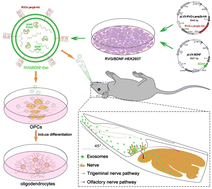High-efficiency brain-targeted intranasal delivery of BDNF mediated by engineered exosomes to promote remyelination†
Abstract
The regeneration of myelin sheaths is the ultimate goal of the treatment of demyelination disease, including multiple sclerosis (MS). However, current drugs for MS mainly target the immune system and can only slow down the disease development and do not promote the differentiation of oligodendrocyte precursor cells (OPCs) abundant in the myelin injury region into mature oligodendrocytes to form a new myelin sheath. Brain-derived neurotrophic factor (BDNF) plays an important role in the regulation of OPC proliferation and differentiation into mature oligodendrocytes. Exosomes, a kind of nanoscale membrane vesicle secreted by cells, can be used as potential therapeutic drug delivery vectors for central nervous system diseases. Here, brain-targeted modification and BDNF intracellular-loaded exosomes were produced through engineering HEK293T cells, which can promote the differentiation of OPCs into mature oligodendrocytes in vitro. The intranasal administration of the brain-targeted engineered exosome-mediated BDNF was a highly effective delivery route to the brain and had a significant therapeutic effect on remyelination and motor coordination ability improvement in demyelination model mice. The combination of intranasal administration with brain-targeted and BDNF-loaded designed exosomes provides a strategy for efficient drug delivery and treatment of central nervous system diseases.

- This article is part of the themed collection: Biomaterials Science Most Popular 2022


 Please wait while we load your content...
Please wait while we load your content...